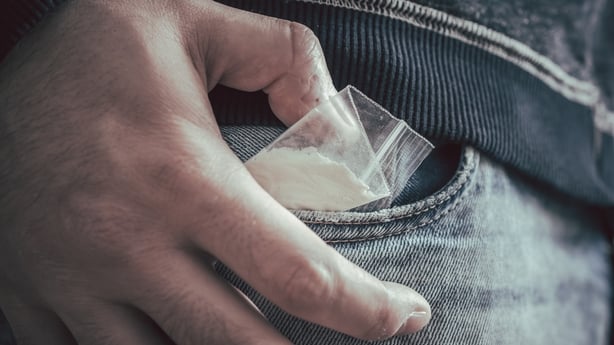13,104 cases were treated for problem drug use last year, according to the Health Research Board.
It is the highest annual number recorded and an increase of more than 1,000 cases compared to 2022.
A case relates to a treatment episode in the National Drug Treatment Reporting System data system and not a person.
This means that the same person could be counted more than once in the same calendar year, if they had more than one treatment episode in that year, according to the HRB.
The findings show that almost four-in-ten cases had never been treated before.
Cocaine was the most common drug reported, accounting for one-in-three cases followed by opioids - mainly heroin - and cannabis and benzodiazepines.
Cocaine was the most common main drug among new cases in 2023, accounting for almost half (46%) of new cases.
In 2023, 4,923 cases were recorded with cocaine as a main problem.
There was a 228% increase in the number of cases where cocaine was the main problem drug between 2017 and 2023.
Powder cocaine increased by 197% during this time and crack cocaine increased by 594%.
For previously treated cases, cocaine accounted for one-in-three cases, the highest number recorded to date.

Socio-demographic characteristics varied depending on the type of cocaine used.
Between 2017 and 2023, there was a 388% increase among females who sought drug treatment for cocaine.
There were 284 cases in 2017 and this figure rose to 1,387 in 2023.
For cases with powder cocaine as the main problem, more than one in five were female, two in five were employed and the median age entering treatment was 31 years old.
When it came to cases where crack cocaine was the main problem, nearly half were female, just over one in 20 were employed and the median age was 39 years.
Different profiles for new and previously treated cases
Cocaine is the most common drug reported among new cases entering drug treatment, with rates rising significantly over the past seven years.
In contrast, the proportion of new cases reporting cannabis or opioids as their main problem drug has decreased.
For those returning to drug treatment, opioids continue to be the leading problem although the rates have declined.
There has been "a steady increase" in the number of cocaine cases returning for treatment.
Opioids were the main drug generating treatment demand for cases aged 40 years or older, an increase compared to earlier years where it was 35 years or older.
The findings show that return rates for cannabis have declined and polydrug use, more than one substance, was reported by almost six-in-ten cases (59%).
Injecting and sharing

The data showed that one-in-five cases reported that they had ever injected (20%).
According to the HRB, the actual number of cases injecting is increased from 2021, with 2,264 in 2021 to 2,659 in 2023.
Among cases with opioids as a main problem, there was a decrease in the proportion injecting - from 93% in 2017 to 76% in 2023.
Of the cases currently injecting, there was an increase problem use of cocaine and also polydrug use.
Among cases who had injected, 40% had shared needles and syringes.
Treatment outcomes
Half of cases exiting treatment in 2023 had engaged for three months or longer.
More than four-in-ten cases had successfully completed their treatment programme or continued to engage with follow on treatment programmes elsewhere.
The HRB said that understanding treatment outcomes helps inform more targeted services and policies, to improve the wellbeing of individuals seeking drug treatment.
HRB Chief Executive Dr Mairéad O'Driscoll said the highest number of cases in treatment recorded last year was "as a result of the sharp rise in cocaine use and an increase in the provision of specific services to treat cocaine use".
Research Officer at the HRB Dr Anne Marie Carew noted that cocaine is the main problem drug for nearly half of new cases to treatment, but also one in three cases returning to treatment.
She said this pointed to a growing future need for treatment for cocaine.
Dr Carew also described the sharp increase in cocaine cases among females as "a concern" and that it highlighted a growing need for prevention measures, especially around crack cocaine.
"Females entering drug treatment are more likely to be living with dependent children," she said.
"Understanding the complex issues they face will help to identify the integrated services they require to address their specific situations," she added.







